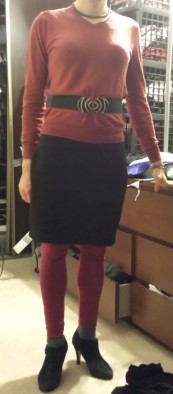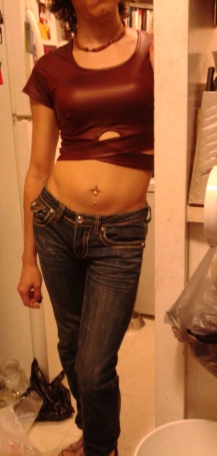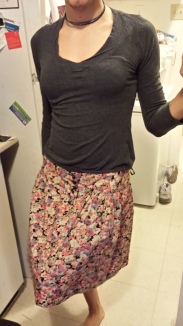I find it strange and a little funny when people comment on my fashion sense. I have no doubt that it’s genuinely praiseworthy, but some of the compliments I’ve received come with a little extra subtext I’d like to put to rest.
This fashion sense is the work of years, not months.
I’ve been paying vastly outsized attention to women’s clothing for my entire life. I’ve been able to render informed opinions on clothing styles and makeup hues since high school, if not earlier. I had weirdly specific ideas about what I wanted the women in my life to wear. I fantasized about and utterly failed to seduce partners who approximated that style in my misguided quest to surround myself with the precise sort of femininity that it turned out I actually wanted, not to be around, but to be. I did not face my more authentic clothing with the anxious confusion of an empty cistern. I turned that spigot and enough fashion came out to dress ten svelte Hispanic ladies. I was not intimidated by no longer being able to dejectedly match any T-shirt with one or another set of jeans and call it a day; I was liberated.
And because I came into this battle well-armed and, after an outpouring of support, well-provisioned, I’m sharing here what wisdom I have about how I look good in women’s clothing.
A basic principle is this: fashion is an exercise in matching. People pick clothing to match their bodies, their own sense of what they should look like, and the occasion, and further match each item to the items previously selected. The innermost core of being considered “fashionable” is having a good grasp on the criteria of color, style, pattern, and so on that comprise that process. Being able to chase new trends or individual expensive pieces doesn’t even make the top-ten list, especially in a culture as saturated with “vintage” as 2010s North America. Wishing to impress the sorts of people who notice those details is an orthogonal concern. Honing intuitions about what things “go with” what other things is 9/10 of the battle, and the other tenth is a good set of heels.
One challenge that made sure I honed those intuitions is that I’ve mostly rejected pants. I spent 28 years wearing jeans, shorts, and slacks that didn’t’ feel right, including a few pairs that felt amazing at the time but are now associated with my incognito phase. This is the time in my life when I get to wear skirts and dresses for every occasion. That’s not easy in a city whose winters sometimes reach -40 °C and as a person whose extremities give up on having a body temperature in the average spring breeze, but I had the amazing fortune to come of feminine age at a time in which leggings are fashionable. Fleece-lined and surprisingly thick, Canadian leggings keep me warm well past when a lot of other women give up and start wearing pants again. It still gets cold enough to require leggings under pants, especially considering that leggings are not windbreaks, but until then, my femininity is that much more explicit.
With that in mind, dresses are basically a femme cheat code. One will never look more put-together than one does wearing a dress, but it’s less than half as much effort as picking out an equally-matched skirt and top. If you have trouble finding top-and-skirt matches that make you happy, consider dresses. If you don’t have time to look for matching items but like to look like you do, consider dresses. Even if none of that is true, consider dresses anyway. Dresses are wonderful. I’m wearing a dress right now.
For when you’re not wearing dresses, which I suppose we all do eventually, there are some other tips. Leggings feature prominently in my next trick, which provides eye-popping results far in excess of its effort:
Skirt in one color, leggings and top in another, accessories in both.

There’s not much as striking as a black skirt atop red leggings and a red sweater, or a bright patterned skirt accenting a black top and leggings. Matching doesn’t mean picking one color and wearing only that color (although it can). It means uniting elements that complement each other into a single cohesive arrangement. A second color can serve as foreground, standing out from the background to draw attention to certain parts of an outfit or of one’s body shape. Denim skirts are particularly effective here, because their thickness and stiffness make sure they stand out from usually-softer backgrounds even more.
Many other mixtures of this sort are possible, but this is where a little skill comes in handy. Mixing patterns, for example, requires a great deal of caution. Unless this is done expertly and with an eye toward finding patterns that complement each other in more subtle ways, combining patterns can appear poorly thought-out and even induce disorientation and migraine-like symptoms in viewers. It is much safer to have one strongly patterned piece surrounded by solid colors than to try to get two bold patterns to cooperate with one another. Prints are easier to mix but present similar concerns. Such pieces often work best when permitted to stand out from a one-color background, as above.
This use of contrast also comes up another way. Women’s clothing, like men’s, runs from form-fitting to loose, and mixing clothing with these attributes has its own set of rules. An outfit consisting entirely of loose pieces will look baggy, shapeless, or even frumpy, and make its wearer look larger than they are. This can be a side effect of well-prioritized comfort but is rarely desirable on its own. Oversized sweaters or loose, flowy skirts are, therefore, best paired with tighter pieces that hint at the shape ostensibly obscured by their looseness. This rule also extends to shoes: my favorite and highest-quality winter boots are nearly knee-height and fairly wide at the top, which combines poorly with skirts or dresses that reach a similar length. Relatedly, mixing clothing textures can be tricky, which is why seasonal fashions don’t generally mix the diaphanous fabrics that suit summer all-year-round. Thin fabrics can bunch and stick to thicker ones by static, which makes them look even more misplaced in out-of-season combinations. One exception I’ve found is that wide, loose crop tops look quite nice on me with filmy ankle-length skirts and sandals. In this instance, my waist is effectively the tighter element mitigating the looseness of the others.

That last bit hints at another tendency I’m enjoying lately: I like showing skin. That started as soon as I started shaving my legs, several years before I recognized my womanhood. I hated wearing shorts for years before that, without really understanding why, but the day I started shaving my legs, I suddenly wanted them on display, forever. Now, I gleefully wear miniskirts, shorts, crop tops, and bikinis for as long as the seasons allow. Naturally, these come with their own rules. Shorts and miniskirts, stylistically, are tools for visually lengthening one’s legs, and that means they pair gloriously with both heels and sandals, which do the same. For the same reason, pairing miniskirts with socks of standard length represents wasted potential. Instead, use ankle length for maximum skin, or knee- or thigh-high for an equally alluring but warmer effect.
The midriff requires a bit more thought. It’s not easy these days to find situations in which crop tops in Canada aren’t a rare display, so it’s harder to acquire data on when it’s socially acceptable to wear them versus when it’s beyond the pale. Outside of high-fashion locales where such daring is rewarded, specific professions prioritizing skin, places that appropriate Indian aesthetics, and similar situations, it’s probably best to not try to make crop tops work at work. Out and about, the next question is the specific boundaries of one’s display. There is a lot of torso between the pieces of one’s underwear, and different tops will end different fractions of the way to one’s waistline; correspondingly, the waistlines of bottoms aren’t all uniform, either. It’s a different stylistic tradition to show a thin ring of midriff that is above one’s navel, versus the wide swath of exposure from a bustier and low-rise jeans, versus the incidental, motion-based reveals of a top that is just a tiny bit small. I’ve had particular success with combining mid-length crop tops with jeans that sit on my hips, exposing my navel (and its lovely piercing) and a small amount of skin beneath it; this is the main situation that convinces me to wear jeans. Crop tops can be tricky to pair with skirts, because many skirts are designed to sit higher on one’s waist than the average crop top is designed to accommodate, but the results are impressive if it’s done well.

A related concern is the total amount of exposed skin. There are four approximate zones of skin exposure that a typical Western outfit might utilize: cleavage, back, midriff, and legs. Large amounts of rear décolletage are found mainly in formal gowns and aren’t friendly to women who need to wear bras, so this zone not a particularly common choice. This and the midriff are frequently discouraged by the social conventions of particular settings, as above. With those two caveats in mind, exhibiting one or two zones is flirtatious and sexy, and exhibiting three or four rapidly exceeds what is socially expected in many settings and tends to, in the West, read as overtly sexualized. A long skirt can be the difference between an outfit featuring a plunging neckline and visible midriff appearing elegant and formal versus overtly provocative; cleavage plus miniskirt is a standard “sexy” combination; and formal gowns often have relatively low necklines plus rear décolletage while approaching floor length. Leg exposure can be mitigated using tights or leggings and/or by using skirts that reach one’s knees. Recognizing these often-unwritten rules is key to pushing and defying them in interesting and useful ways, which is one of the fun parts of being a fashion-minded exhibitionist.

That’s not an easy thing for a trans woman to be, for a lot of reasons. I’ve learned to compensate for some of those reasons with stylistic choices that reduce the impact of various foci of my bodily insecurity. A woman in my position isn’t well served by taking up the unfairly-maligned leggings-as-pants trend, for example, and I avoid this. I’m insecure about my shoulders, so I carefully contrast the shape of my necklaces with the necklines of my tops. V-shaped necklines reduce the apparent width of shoulders, as does making sure one’s tops are actually the right width for their shoulders. Round or square necklines can be effectively rescued with V-shaped necklaces. My hips are narrower than they would have been if my first puberty had featured more estrogen, so I make extensive use of A-line skirts that that sit high on the waist, so that they flare outward from well above my hips. Making the skirt the focal point of an outfit pulls attention away from higher up on the torso, where many gender-related insecurities dwell. Virtually every body part has style tricks that accentuate or deemphasize it, so those of us who don’t want to, or can’t easily, put our insecurities on stark and unforgiving display can still feel good about our bodies and our clothing choices.
The most underestimated rule of being perceived as fashionable is perhaps also the most cliché: accessorize. In many situations, what makes or breaks an erstwhile fashionista is cunning use of jewelry, belts, shoes, and other small complements to one’s overall outfit. A big statement necklace can enliven a plain white top or reduce the harshness of an unforgiving neckline. A prominent belt can draw attention to a slim waist (and away from nearby problem areas). Shoes are quite honestly worth multiple essays all on their own for their ability to complete, derail, and otherwise decide whether an outfit works or doesn’t. The variety of jewelry and similar items available for this role is such that specific advice would take far too much space, so one more general tip is in order: it is a good idea to match the color of an accessory to a secondary color in one’s outfit. If one is using the skirt in one color, leggings and top in another model from earlier, matching one’s jewelry and/or shoes to the skirt helps bring the whole outfit into cohesion. (Matching the other way around can make accessories disappear against the similarly-colored background.) Accessories that borrow colors from the single patterned piece of an otherwise block-color outfit achieve similar unity. The smallness of accessories means that they can easily serve to connect otherwise disparate clothing items and this power should be exploited to the fullest.

That’s a lot more to think about all at once than is realistically possible for anyone. It’s better and easier to treat all of these as questions to ask during outfit assembly. When deciding what to wear, I almost always start with a specific piece I’d like to showcase and select each subsequent item based on what fits with the previous selections and the priorities of the day. It’s easy to fall into a rut of always wearing the same or similar items out of habit or convenience, especially for a woman as insistent on routine as I am, so forcing myself to complement specific recently-unused items keeps my clothes on a more consistent rotation and keeps my fashion skills honed. I’ll have more options in the spring, when not everything has to work with one of my warmer sets of leggings, which are all red, blue, or black.
And that’s why I will fight anyone who tells me that fashion is boring, frivolous, unintelligent, or otherwise not the activity of serious and thoughtful people. Clothing is a language, and the sentences that can be formed from it are rich, varied, and ever more interesting now that I get to speak it in my own voice.



I love your heeled slingback shoes and tree print dress. If I was slimmer (like I used to be) I would like to wear dresses. It looks like you’ve gone into a lot of thought about this. 🙂
I never stop thinking, about this or anything else. It’s why I write 🙂
I see your passion 🙂 do you work in textiles or fashion? I’m in my early 40s and finally seriously studying design (I love textiles, embroidery especially).
I’m a fish biologist by trade, hoping to go into animal husbandry or teaching. Anything but research 😛 Fashion is one of many, MANY hobbies and interests I maintain.
Honestly, I only came into femme expression like…roughly 3 years ago 🙁 And before then I was a mess! Learning so much from this. I still don’t know how to accessorise, and I use *the same belts that dresses in the shop come with* because I have yet to learn how colours go together sigh. My default is black things because in my head, I was like “well black goes with everything” which like sure, but I’m soon on my way to being a 30 year old who can’t match! I also have an orange scarf now that I don’t know what to do with except basically be halloween anytime I wear it (orange and black is an unforgiving combination in north america)
I look forward to the chance to shop with you and try a whole bunch of new things together <3
yess we must plan! :3 :3